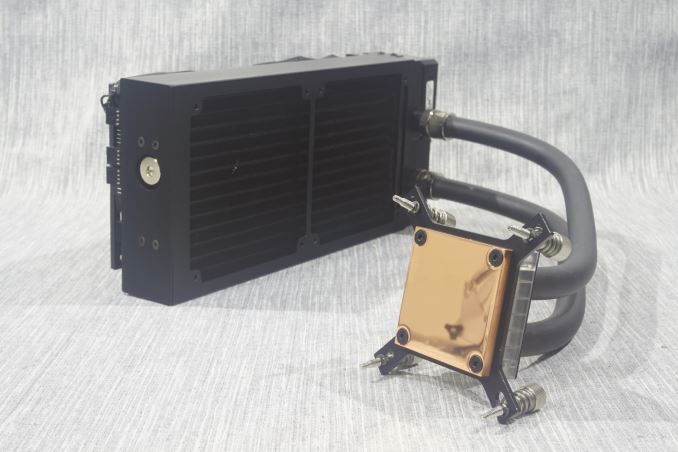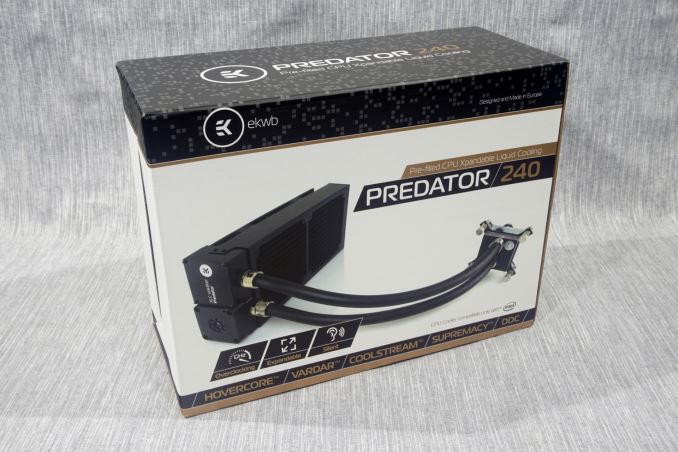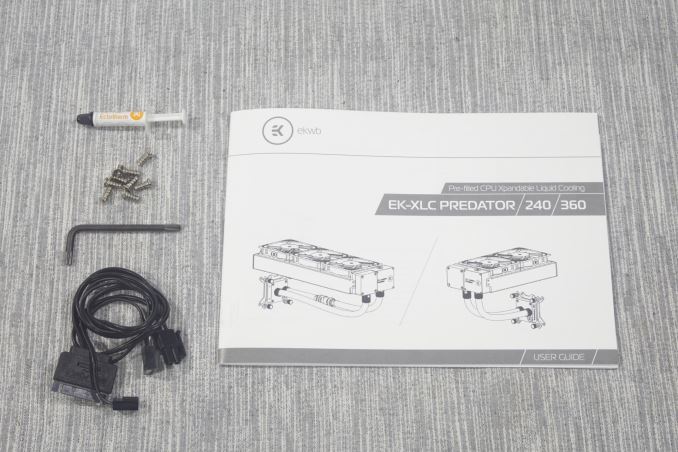The EKWB EK-XLC Predator 240 Liquid Cooler Review
by E. Fylladitakis on December 15, 2015 9:00 AM EST- Posted in
- Cases/Cooling/PSUs
- AIO
- Water Cooling
- Liquid Cooling
- EKWB

Today we are having a look at the EK-XLC Predator 240, the first AIO liquid cooling solution from EKWB. EKWB is a company that specializes in and is known by their custom liquid cooling products, but with the EK-XLC Predator 240, the company is trying to bring the performance of their custom liquid cooling solutions to the AIO market. We are thoroughly examining and comparing their new product in this review.
Introduction
Ever since liquid cooling became a small trend in the 90's, when enthusiasts were using car radiators and aquarium pumps to cool down their heavily overclocked Athlons and Durons, many companies were founded, focused on custom advanced cooling solutions. However the combination of the relatively high cost and complexity of a liquid cooling system, plus the increasing energy efficiency of modern processors, kept demand for such systems and parts low. As a result, very few of these companies survived to this date. EK Water Blocks, or EKWB for short, is one of them.
EKWB is a company that originates from Slovenia. They are one of the oldest liquid-cooling focused companies around and today they are certainly one of the most popular PC custom liquid cooling manufacturers. They are mainly focused on designing individual liquid cooling parts, such as motherboard and GPU-specific cooling blocks, reservoirs and radiators. However, the bulk of the interest on liquid cooling systems today is on all-in-one (AIO) solutions that are ready to be installed and operate with little knowledge beyond knowing how to install a basic PC. EKWB has realized that and recently released two ready-to-go AIO cooling kits with a twist - these can also be upgraded and expanded. Today we are having a look at the EK-XLC Predator 240, the "small" kit that is featuring a 240 mm radiator.
Packaging & Bundle
The cardboard box that the Predator 240 came in is not particularly strong but the product is very well protected within a plastic shell inside it, ensuring that it will be delivered without damage. The artwork is simple, direct and elegant, mainly focused on a picture of the unit itself and it promotes its most significant features.
EKWB supplies the most basic bundle that we have ever seen coming with an AIO cooler. Inside the box we only found the power cable that is necessary to power the unit (a derivative of a SATA power cable), a few mounting screws, a Torx driver, thermal paste and a user's guide. The user's guide is by far the most interesting piece of the bundle, being well-written and illustrated, making it very useful. Note however that certain parts of the guide assume that the user is a fairly advanced DIY enthusiast, suggesting, for example, the removal of the CPU's lid or the internal cleaning of the water block. The instructions are detailed enough for an advanced user to partake such tasks, describing the process and the tools/chemicals/substances that may be necessary. However, several of these recommendations are absolutely not for amateurs and could result to major equipment damage when not performed adequately.













36 Comments
View All Comments
shaolin95 - Thursday, December 17, 2015 - link
er no...its the top Air Cooler but no it does not "blow away almost all of these coolers" plus not everyone likes such huge thing on your build.I used to my tastes got refined and no longer like that huge chunk of metal there not to mention that its harder to clean between fins compared to a radiator.
stren - Thursday, December 17, 2015 - link
Yes using a lab grade setup like that is great for more accurate system measurements. It's damn hard to test radiators well after all - ask my buddy fast_fate about that. *But* a good amount of performance can be gained or lost from bow of the CPU block and how well it matches the CPU's IHS. One thing you failed to mention in your methodology is how the block was mounted to the heater plate. Which TIM was used? How many mounts did you do? Mounts can produce quite variable results. Typically a 1C variance might be seen in mounting one block to one CPU in one orientation. Different CPUs and orientations will produce a wider spread still. In addition measuring ambient air in is extremely hard to do well even if your sensors are world class. How many sensors do you use, how spread out are they, how far from the fans are they? Is there an intake manifold? Is the manifold restrictive? Is there any other airflow in the room? How much does the ambient change? What's the error in the system? How long do you log for, how many runs do you average etc etc?If you were to test CPU water blocks independently on a such a setup the results would be very different to those testing on a real motherboard/CPU. This is particularly true when a small difference in mount height can change mounting pressure and hence TIM thickness. Some block mounts bottom out rather than relying on a set torque to tighten and hence making your own mount will mean a difference in mounting pressure than a real motherboard/CPU combo.
In essence while you're testing *part* of the system very accurately, you're not testing the whole system accurately. While I applaud the effort to measure AIO's well, I think you'd do well to drop the lower power runs where the margin of error is > than the difference in the data in order to save time and also test with a CPU to try and see some impact of the mount on a real world system. Of course the latter can be frustrating to get the accuracy required. Taking data on ten water blocks accurately on one CPU can take me a month. So I can understand why you'd want to limit the variables, but it might be wise to mention that by limiting the variables in order to be more accurate you are also making the test less accurate by being a simulation of the real thing.
r4serei - Friday, December 18, 2015 - link
i'm lovin my 240. i've already expanded onto it with a block for my gpu and another rad. was surprisingly simple.r4serei - Wednesday, January 13, 2016 - link
EK has issued a recall for all revision 1.0 Predators due to a faulty O-ring. It's been corrected on revision 1.1 which has been released as of Jan 4th.alexrw - Saturday, January 30, 2016 - link
> the pressure triples for every increase of 3 dB(A)err, doubles ... actually almost doubles (the exact value when it exactly doubles is not 3dB but 10*log10(2)=3.0102999 dB, or conversely the ratio for exactly 3dB is not 2 but 10^(3/10)=1.99526)
file2man - Sunday, October 30, 2016 - link
I recently purchased the ekwb extreme 360 kit- it has a separate pump, reservoir, clear tubing for somwhere around $350 at microcenter. the pump is not variable speed like most other bought outside of kits and can only vary its speed by a fan controller. Im new at liquid cooling but I suspect hard tubing will in the longer term attract less sediment and is much preferred . Have not reached ek yet but not sure if I can use the 360 extreme kit fittings 13/10mm g1/4 for hard tubing literature says soft tubing is 9.5mm/12.7mm (3/8/1/2 inch). Any help is appreciated since is no way to email ek